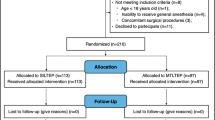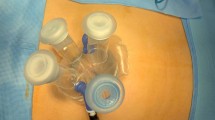Abstract
Purpose
Laparoscopic totally extraperitoneal hernia repair (TEP) is a widely used treatment for inguinal hernia. Single-incision laparoscopic TEP (SILTEP) has attracted the attention of several surgeons, given its superior cosmetic results and patient satisfaction, as well as comparable outcomes to multiport surgery. Nonetheless, no relevant studies have evaluated the learning curve (LC) of SILTEP in terms of both operation time (OT) and surgical failure. Therefore, we aimed to investigate the LC of SILTEP for inguinal hernia.
Methods
Medical records of 180 patients who underwent SILTEP performed by a single surgeon from a single institution between October 2012 and November 2017 were retrospectively reviewed. The LC was analyzed using the moving average method and cumulative sum control chart (CUSUM) for OT and surgical failure. Surgical failure was defined as the need for additional ports, open conversion, severe postoperative complications (Clavien–Dindo ≥ IIIa), and recurrence. Eight patients who underwent combined surgery or bilateral hernia repair were excluded from the OT analysis.
Results
From CUSUM graphs, the study period was divided into three phases: OT-phases 1 (1st–32nd), 2 (33rd–83rd), and 3 (84th–172nd) for OT and failure-phases 1 (1st–29th), 2 (30th–58th), and 3 (59th–180th) for surgical failure. Mean OTs were statistically different in the three OT phases (64.6 vs. 50.8 vs. 35.2 min; p < 0.001). Open conversion (31.0% vs. 0% vs. 2.5%) and additional port insertion (6.9% vs. 24.1% vs. 2.5%) stabilized consecutively at failure-phases 2 and 3 (p < 0.001). Surgical failure rates decreased to 5.7% by failure-phase 3 (37.9% vs. 24.1% vs. 5.7%; p < 0.001).
Conclusion
For an experienced laparoscopic surgeon, we estimated that approximately 60 cases are needed to overcome the LC for SILTEP in terms of both reducing OT and achieving a surgical failure rate < 10%. Further proficiency could be achieved after approximately 85 SILTEP procedures with a stable OT of approximately 35 min.




Similar content being viewed by others
References
Han SR, Kim HJ, Kim NH, Shin S, Yoo RN, Kim G, Cho H-M (2019) Inguinal hernia surgery in Korea: nationwide data from 2007–2015. Ann Surg Treat Res 97:41–47
Cardinali L, Mazzetti CH, Febres AC, Repullo D, Bruyns J, Dapri G (2018) Prospective randomized study comparing single-incision laparoscopic versus multi-trocar laparoscopic totally extraperitoneal (TEP) inguinal hernia repair at 2 years. Surg Endosc 32:3262–3272
Park SJ, Lee KY, Lee S-H (2020) Laparoscopic surgery for colorectal cancer in korea: nationwide data from 2013 to 2018. Cancer Res Treat 52:938–944
HerniaSurge Group (2018) International guidelines for groin hernia management. Hernia 22:1–165
Wakasugi M, Tei M, Anno K, Mikami T, Tsukada R, Koh M, Furukawa K, Suzuki Y, Masuzawa T, Kishi K (2016) Single-incision totally extraperitoneal inguinal hernia repair is safe and feasible in elderly patients: a single-center experience of 365 procedures. Asian J Endosc Surg 9:281–284
Wakasugi M, Nakahara Y, Hirota M, Matsumoto T, Kusu T, Takemoto H, Takachi K, Oshima S (2019) Learning curve for single-incision laparoscopic totally extraperitoneal inguinal hernia repair. Asian J Endosc Surg 12:301–305
Kim CW, Kim WR, Kim HY, Kang J, Hur H, Min BS, Baik SH, Lee KY, Kim NK (2015) Learning curve for single-incision laparoscopic anterior resection for sigmoid colon cancer. J Am Coll Surg 221:397–403
Grigg O, Spiegelhalter D (2010) Clinical surveillance and patient safety. In: Smith PC, Mossialos E, Papanicolas I, Leatherman S (eds) Performance measurement for health system improvement: experiences, challenges and prospects. Cambridge University Press, Cambridge, pp 286–310
Dindo D, Demartines N, Clavien PA (2004) Classification of surgical complications: a new proposal with evaluation in a cohort of 6336 patients and results of a survey. Ann Surg 240:205–213
Cohen RV, Alvarez G, Roll S, Garcia ME, Kawahara N, Schiavon CA, Schaffa TD, Pereira PR, Margarido NF, Rodrigues AJ (1998) Transabdominal or totally extraperitoneal laparoscopic hernia repair? Surg Laparosc Endosc 8:264–268
Van Hee R, Goverde P, Hendrickx L, Van der Schelling G, Totte E (1998) Laparoscopic transperitoneal versus extraperitoneal inguinal hernia repair: a prospective clinical trial. Acta Chir Belg 98:132–135
Gass M, Banz VM, Rosella L, Adamina M, Candinas D, Guller U (2012) TAPP or TEP? Population-based analysis of prospective data on 4,552 patients undergoing endoscopic inguinal hernia repair. World J Surg 36:2782–2786
Dulucq JL, Wintringer P, Mahajna A (2009) Laparoscopic totally extraperitoneal inguinal hernia repair: lessons learned from 3,100 hernia repairs over 15 years. Surg Endosc 23:482–486
Kim CW, Lee KY, Lee SC, Lee SH, Lee YS, Lim SW, Kim JG (2017) Learning curve for single-port laparoscopic colon cancer resection: a multicenter observational study. Surg Endosc 31:1828–1835
Gavriilidis P, Davies RJ, Wheeler J, De’Angelis N, Di Saverio S (2019) Total extraperitoneal endoscopic hernioplasty (TEP) versus Lichtenstein hernioplasty: a systematic review by updated traditional and cumulative meta-analysis of randomised-controlled trials. Hernia 23:1093–1103
Chung CS, Lee DK (2013) Laparoscopic inguinal hernia repair: a review of 1,000 cases. J Minim Invasive Surg 16:21–25
Gass M, Banz VM, Rosella L, Adamina M, Candinas D, Güller U (2012) TAPP or TEP? population-based analysis of prospective data on 4,552 patients undergoing endoscopic inguinal hernia repair. World J Surg 36:2782–2786
Köckerling F, Bittner R, Jacob D, Seidelmann L, Keller T, Adolf D, Kraft B, Kuthe A (2015) TEP versus TAPP: comparison of the perioperative outcome in 17,587 patients with a primary unilateral inguinal hernia. Surg Endosc 29:3750–3760
Choi YY, Kim Z, Hur KY (2012) Learning curve for laparoscopic totally extraperitoneal repair of inguinal hernia. Can J Surg 55:33–36
Kwon OC, Baik YH, Oh MG, Park YJ, Kwak BS, Han IW (2016) The learning curve for laparoscopic totally extraperitoneal herniorrhaphy by logarithmic function. J Minim Invasive Surg 19:126–129
Suguita FY, Essu FF, Oliveira LT, Iuamoto LR, Kato JM, Torsani MB, Franco AS, Meyer A, Andraus W (2017) Learning curve takes 65 repetitions of totally extraperitoneal laparoscopy on inguinal hernias for reduction of operating time and complications. Surg Endosc 31:3939–3945
Lau H, Patil NG, Yuen WK, Lee F (2002) Learning curve for unilateral endoscopic totally extraperitoneal (TEP) inguinal hernioplasty. Surg Endosc 16:1724–1728
Lim JW, Lee JY, Lee SE, Moon JI, Ra YM, Choi IS, Choi WJ, Yoon DS, Min HS (2012) The learning curve for laparoscopic totally extraperitoneal herniorrhaphy by moving average. J Korean Surg Soc 83:92–96
Wakasugi M, Tei M, Suzuki Y, Furukawa K, Masuzawa T, Kishi K, Tanemura M, Akamatsu H (2017) Single-incision totally extraperitoneal inguinal hernia repair is feasible and safe in patients on antithrombotic therapy: a single-center experience of 92 procedures. Asian J Endosc Surg 10:301–307
Wakasugi M, Nakahara Y, Hirota M, Matsumoto T, Takemoto H, Takachi K, Nishioka K, Oshima S (2019) Efficacy of single-incision laparoscopic totally extraperitoneal repair for irreducible or incarcerated inguinal hernia. Asian J Endosc Surg 12:95–100
Kim SJ, Choi BJ, Lee SC (2014) Overview of single-port laparoscopic surgery for colorectal cancers: past, present, and the future. World J Gastroenterol 20:997–1004
Acknowledgements
The authors thank C.W. Kim for statistical advice.
Funding
No funding was received for this research.
Author information
Authors and Affiliations
Contributions
Conceptualization: YYP and JL. Data acquisition: YYP, KL, STO, and JL. Statisticalanalysis: YYP, KL, and STO. Writing—original draft: YYP. Writing—review and editing: YYP and JL.
Corresponding author
Ethics declarations
Conflict of interest
Drs. Youn Young Park, Kil-yong Lee, Seong Taek Oh, and Jaeim Lee have no conflict of interests or financial ties to disclose.
Ethics approval
This study was conducted in accordance with the ethical standards laid down in the 1964 Declaration of Helsinki and its later amendments or comparable ethical standards and was approved by the Institutional Review Board of Uijeongbu St. Mary’s Hospital, The Catholic University of Korea, South Korea (no. UC20RISI0128).
Consent to participate
The requirement for acquisition of informed consent from patients was waived by the Institutional Review Board of Uijeongbu St. Mary’s Hospital.
Additional information
Publisher's Note
Springer Nature remains neutral with regard to jurisdictional claims in published maps and institutional affiliations.
Rights and permissions
About this article
Cite this article
Park, Y.Y., Lee, K., Oh, S.T. et al. Learning curve of single-incision laparoscopic totally extraperitoneal repair (SILTEP) for inguinal hernia. Hernia 26, 959–966 (2022). https://doi.org/10.1007/s10029-021-02431-7
Received:
Accepted:
Published:
Issue Date:
DOI: https://doi.org/10.1007/s10029-021-02431-7




